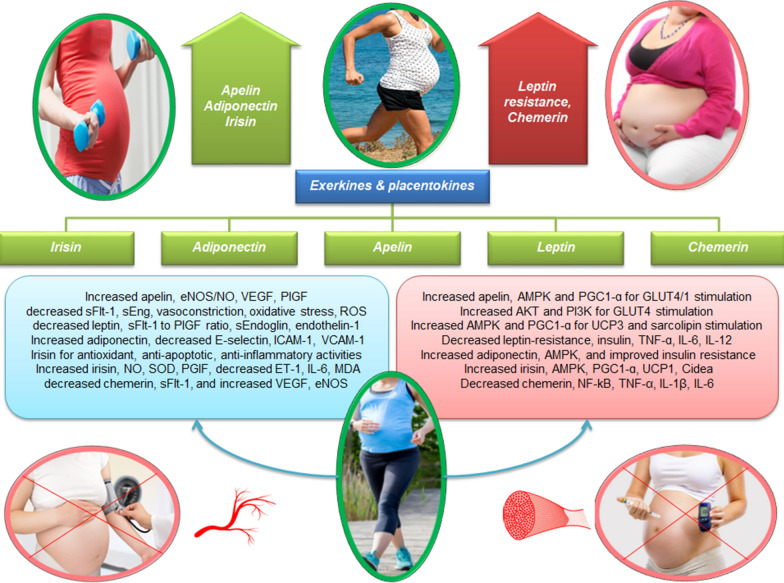Fig. 3.
Effects of exerkines and placentokines on gestational diabetes and preeclampsia. Apelin and exercise increase AMPK, PI3k, and AKT1, leading to GLUT4, GLUT1, and PGC-1α stimulation in pregnant rats. This process then increases the expression of UCP3 and sarcolipin for thermogenesis. Acute exercise also increases VEGF mRNA via AMPK and, increases eNOS/NO production and decreases reactive oxygen species in placental vasculature. Decreased leptin induced by regular exercise during pregnancy is associated with increased serum concentration of PlGF and decreased sFlt-1, sEng, and endothelin-1. Exercise during pregnancy acts as an antioxidant and leads to a decrease in leptin, TNF-α, IL-6, and IL-12 levels. Exercise also improves central sensitivity to leptin, which is known as the phenomenon of leptin sensitization. Higher levels of adiponectin are associated with greater physical activity, and AMPK activation through adiponectin is an important process for glucose and lipid metabolism. Increasing the concentration of adiponectin leads to the decrease of E-selectin, ICAM-1, VCAM-1, and suppression of vascular inflammation. In active women, irisin is slightly increased and directly improves muscle metabolism through AMPK activation and then stimulates PGC-1α, which in turn leads to increased mRNA expression of UCP1 and cidea, increased thermogenesis, and increased adipose tissue browning. Irisin also leads to a significant decrease in systolic blood pressure, diastolic blood pressure, ET-1, IL-6, and MDA and a significant increase in SOD, PGF, and NO in patients with preeclampsia. In the peripheral blood of gestational diabetes patients, the expression of chemerin is positively correlated with the inflammatory factors IL-6 and TNF-α, while the level of chemerin decreases in the exercise + diet groups. Overexpression of chemerin through the CMKLR1 receptor in human trophoblasts leads to increased sFlt-1, decreased VEGF-A, and eNOS, which contributes to preeclampsia. On the other hand, 6 months of training reduces the level of chemerin significantly

